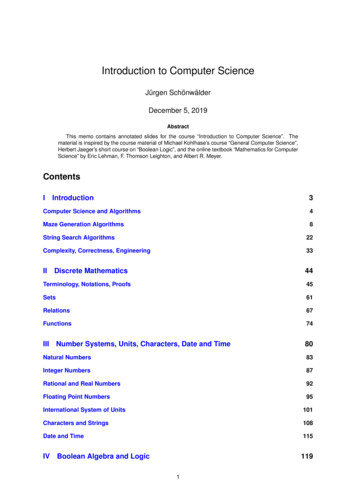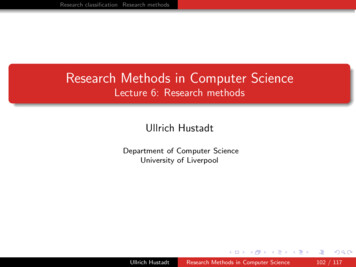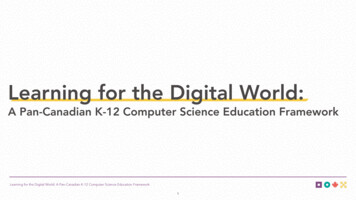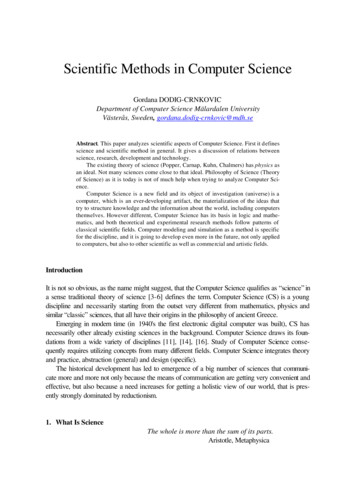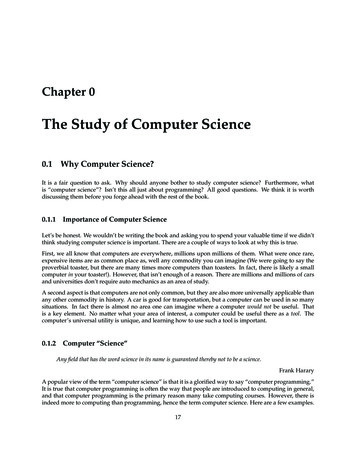
Transcription
Chapter 0The Study of Computer Science0.1 Why Computer Science?It is a fair question to ask. Why should anyone bother to study computer science? Furthermore, whatis “computer science”? Isn’t this all just about programming? All good questions. We think it is worthdiscussing them before you forge ahead with the rest of the book.0.1.1 Importance of Computer ScienceLet’s be honest. We wouldn’t be writing the book and asking you to spend your valuable time if we didn’tthink studying computer science is important. There are a couple of ways to look at why this is true.First, we all know that computers are everywhere, millions upon millions of them. What were once rare,expensive items are as common place as, well any commodity you can imagine (We were going to say theproverbial toaster, but there are many times more computers than toasters. In fact, there is likely a smallcomputer in your toaster!). However, that isn’t enough of a reason. There are millions and millions of carsand universities don’t require auto mechanics as an area of study.A second aspect is that computers are not only common, but they are also more universally applicable thanany other commodity in history. A car is good for transportation, but a computer can be used in so manysituations. In fact there is almost no area one can imagine where a computer would not be useful. Thatis a key element. No matter what your area of interest, a computer could be useful there as a tool. Thecomputer’s universal utility is unique, and learning how to use such a tool is important.0.1.2 Computer “Science”Any field that has the word science in its name is guaranteed thereby not to be a science.Frank HararyA popular view of the term “computer science” is that it is a glorified way to say “computer programming.”It is true that computer programming is often the way that people are introduced to computing in general,and that computer programming is the primary reason many take computing courses. However, there isindeed more to computing than programming, hence the term computer science. Here are a few examples.17
Theory of ComputationBefore there were the vast numbers of computers that are available today, scientists were thinking aboutwhat it means to do computing and what the limits might be. They would ask questions, such as do thereexist problems that we can conceive of but cannot compute? It turns out there are. One of these problems,called the “Halting Problem”1 , cannot be solved by a program running on any computer. Knowing whatyou can and cannot solve on a computer is an important issue and a subject of study among computerscientists that focus on the theory of computation.Computational EfficiencyThe fact that a problem is computable does not mean it is easily computed. Knowing roughly how difficulta problem is to solve is also very important. Determining a meaningful measure of difficulty is, in itself, aninteresting issue, but imagine we are concerned only with time. Consider designing a solution to a problemthat, as part of the solution, required you to sort 100,000 items (say cancer patient records, or asteroid names,or movie episodes, etc). A slow algorithm, such as the sorting algorithm called the Bubble Sort might takeapproximately 800 seconds (about 13 minutes) while another sorting algorithm called Quick Sort mighttake approximately 0.3 seconds. That is a difference of around 2400 times! That large a difference mightdetermine whether it is worth doing or not. If you are creating a solution, it would be good to know whatmakes your solution slow or what makes it fast.Algorithms and Data StructuresAlgorithms and Data Structures are the currency of the computer scientist. Discussed more in Chapter 3,algorithms are the methods used to solve problems, and data structures are the organizations of data thatthe algorithms use. These two concepts are distinct: a general approach to solving a problem (such assearching for a particular value, sorting a list of objects, encrypting a message, etc.) differs from the organization of the data that is being processed (as a list of objects, as a dictionary of key-value pairs, as a “tree”of records). However, they are also tightly coupled. Furthermore, both algorithms and data structures canbe examined independently of how they might be programmed. That is, one designs algorithms and datastructures and then actually implements them in a particular computer program. Understanding abstractlyhow to design both algorithms and data structures independent of the programming language is criticalfor writing correct and efficient code.Parallel ProcessingIt may seem odd to include what many consider an advanced topic, but parallel processing, using multiplecomputers to solve a problem, is an issue for everyone these days. Why? As it turns out, most computerscome with at least two processors or CPUs (see Section 0.6), and many with four or more. The presentday PlayStation3 uses a special IBM chip that has eight processors, and Intel has recently announcedprototypes of chips that have eighty processors! What does this mean to us, both as consumers and newcomputer scientists?The answer is that new algorithms, data structures and programming paradigms will be needed to takeadvantage of this new processing environment. Orchestrating many processors to solve a problem is anexciting and challenging task.1 http://en.wikipedia.org/wiki/Halting problem18
Software EngineeringEven the process of writing programs itself has developed its own sub discipline within computer science. Dubbed “Software Engineering”, it concerns the process of creating programs: from designing thealgorithms they use, to supporting testing and maintenance of the program once created. There is even adiscipline interested in representing a developed program as a mathematical entity so that one can provewhat a program will do once written.Many OthersWe have provided but a taste of the many fields that make computer science such a wonderfully rich areato explore. Every area that uses computation brings its own problems to be explored.0.1.3 Computer Science Through Computer ProgrammingWe have tried to make the point that computer science is not just programming. However, it is also true thatfor much of the book we will focus on just that aspect of computer science: programming. Beginning with“problem solving through programming” allows one to explore pieces of the computer science landscapeas they naturally arise.0.2 The Difficulty and Promise of ProgrammingIf computer science, particularly computer programming, is so interesting, why doesn’t everybody do it?The truth is, it can be hard. We are often asked by beginning students, “Why is programming so hard”?Even grizzled programming veterans, when honestly looking back at their first experience, remember howdifficult that first programming course was. Why? Understanding why it might be hard gives you an edgeon what you can do to control the difficulty.0.2.1 Difficulty 1: two things at onceLet’s consider an example. Let us say that, when you walk into that first day of programming 101, you discover the course is not about programming but French poetry. French poetry? Yes, French poetry. Imaginethat you come in and the professor posts the following excerpt from a poem on the board.A une Damoyselle maladeMa mignonne,Je vous donneLe bon jour;Le séjourC’est prison.Clément MarotYour assigned task is to translate this poetry into English (or German, or Russian, whatever language isyour native tongue). Let us also assume, for the moment, that:19
a ) You do not know French.b ) You have never studied poetry.You have two problems on your hands. First, you have to gain a better understanding of the syntax andsemantics (the form and substance) of the French language. Second, you need to learn more about the“rules” of poetry and what constitutes a good poem.Lest you think that this is a trivial matter, an entire book has been written by Douglas Hofstadter on thevery subject of the difficulty of translating this one poem (“Le Ton beau de Marot”).So what’s your first move? Most people would break out a dictionary and, line-by-line, try to translate thepoem. Hofstadter, in his book, does exactly that, producing the crude translation in Figure 1.My Sweet/Cute [One](Feminine)My sweet/cute [one](feminine)I [to] you (respectful)give/bid/conveyThe good day (i.e., ahello, i.e., greetings).The stay/sojourn/visit(i.e., quarantine){It} is prison.A une Damoyselle maladeMa mignonne,Je vous donneLe bon jour;Le séjourC’est prison.Figure 1: Crude Translation of excerpt.The result is hardly a testament to beautiful poetry. This translation does capture the syntax and semantics,but not the poetry, of the original. If we take a closer look at the poem, we can discern some features that agood translation should incorporate. For example: Each line consists of three syllables. Each line’s main stress falls on its final syllable. The poem is a string of rhyming couplets: AA, BB, CC, . . . The semantic couplets are out of phase with the rhyming couplets: A, AB, BC, . . .Taking some of these ideas (and many more besides) into account, Hofstadter comes up with the translationin Figure 2.Not only does this version sound far more like poetry, but it also matches the original poem, following therules and conveying the intent. It is a pretty good translation!Poetry to Programming?How does this poetry example help? Actually, the analogy is pretty strong. In coming to programming forthe first time, you face exactly the same issues: You are not yet familiar with the syntax and semantics of the language you are working with—in thiscase, the programming language Python and perhaps not with any programming language.20
My Sweet DearA une Damoyselle maladeMy sweet dear,I send cheer –All the best!Your forced restIs like jail.Ma mignonne,Je vous donneLe bon jour;Le séjourC’est prison.Figure 2: Improved Translation of excerpt. You do not know how to solve problems using a computer—similar to not knowing how to writepoetry.Just like the French poetry neophyte, you are trying to solve two problems simultaneously. On one level,you are just trying to get familiar with the syntax and semantics of the language. At the same time youare tackling a second, very difficult task: creating poetry in the example above; solving problems using acomputer in this course.Working at two levels, the meaning of the programming words and then the intent of the program (whatthe program is trying to solve) are the two problems the beginning programmer has to face. Just like theFrench poetry neophyte, our first programs will be a bit clumsy as we learn both the programming languageand how to use that language to solve problems. For example, to a practiced eye, many first programs looksimilar in nature to the literal translation of Hofstadter’s in Figure 1. Trying to do two things simultaneouslyis difficult for anyone, so be gentle on yourself as you go forward with the process.You might ask, isn’t there a better way? Perhaps, but we have not found it yet. The way to learn programming is to program, just like swinging a baseball bat, playing the piano, playing well at bridge; you canhear the rules and talk about the strategies, but learning is best done by doing.0.2.2 Difficulty 2: What is a good program?Having mastered some of the syntax and semantics of a programming language, how do we write a goodprogram? That is, how do we create a program that is more like poetry than like the mess arrived at throughliteral translation.It is difficult to discuss a good program when, at this point, we know so little, but there are a couple ofpoints that are worth noting even before we get started.It’s all about problem solvingIf the rules of poetry are what guides writing good poetry, what are the guidelines for writing good programs? That is, what is it we have to learn in order to transition from a literal translation to a good poem?For programming, it is problem solving. When you write a program, you are creating, in some detail,how it is that you think a particular problem some class of problems, should be solved. Thus, the programrepresents, in a very accessible way, your thoughts on problem solving. Your thoughts! That means, beforeyou write the program you must have some thoughts.It is a common practice, even among veteran programmers, to get a problem and immediately sit downand start writing a program. Typically that approach results in a mess, and, for the beginning programmer,21
it results in an unsolved problem. Figuring out how to solve a problem requires some initial thought. If youthink before you program, you better understand what the problem requires as well as the best strategiesyou might use to solve that problem.Remember the two-level problem? Writing a program as you figure out how to solve a problem meansyou are working at two levels at once: the problem solving level and the programming level. That is moredifficult than doing things sequentially. You should sit down and think about the problem and how youwant to solve it before you start writing the program. We will talk more about this later, but the rule is:R ULE 1: Think before you program!A program as an essayWhen students are asked “What is the most important feature a program should have”, many answer “Itshould run”. By “run”, they mean that the program executes and actually does something.Wrong. As with any new endeavor, it is important to get the fundamentals correct right at the beginning.So Rule 2 isR ULE 2: A program is a human-readable essay on problem solving that also happens to executeon a computer.A program is an object to be read by another person, just as any other essay. While it is true that a programis written in such a way that a computer can execute it, it is still a human-readable essay. If your program iswritten so that it runs, even runs correctly (notice we have not discussed “correctly” yet!) but is unreadable,then it is really fairly worthless.The question is why? Why should it be that people must read it? Why isn’t running good enough? Who’sgoing to read it anyway? Let’s answer the last question first. The person who is going to read it the mostis you! That’s correct, you have to read the programs you are writing all the time. Every time you putyour program away for some period of time and come back to it, you have to re-read what you wrote andunderstand what you were thinking. Your program is a record of your thoughts on solving the problemand you have to be able to read your program in order to work with it, update it, add to it, etc.Furthermore, once you get out of the academic environment where you write programs solely for yourself,you will be writing programs with other people as a group. Your group mates have to be able to read whatyou wrote! Think of the process as developing a newspaper edition. Everyone has to be able to read eachothers’ content so that the edition, as a whole, makes sense. Just writing words on paper isn’t enough—theyhave to fit together.Our goal is to write programs that other people can read, as well as be run.0.2.3 The Promise of a Computer ProgramA program is an essay on problem solving and that will be our major focus. However, it is still interestingthat programs do indeed run on a computer. That is, in fact, one of the unique, and most impressive partsabout a program. Consider that idea for a moment. You can think of a way to solve a problem, write thatthought down in detail as a program, and (assuming you did it correctly) that problem gets solved. Moreimportantly, the problem can be solved again and again because the program can be used independent ofyou. That is, your thoughts not only live on as words (because of the essay-like nature of the program),but also as an entity that actually implements those thoughts. How amazing is that! Do you have somethoughts about how to make a robot dance? Write the program, and the robot dances. Do you have someideas on how to create music? Write the program, and music is written automatically. Do you have an ideaof how to solve a Sudoku puzzle? Write the program, and every puzzle is solved.22
So a computer program (and the computer it runs on) offers a huge leap forward, perhaps the biggest sinceGutenberg in the mid 1400’s. Gutenberg invented moveable type, so that the written word of an individual,i.e. their thoughts, could be reproduced independently of the writer. Now, not only can those thoughts becopied, but also implemented to be used over and over again.Programming is as open, as universally applicable, as the thoughts of the people who do the programming,because a program is the manifest thought of the programmer.0.3 Choosing a Computer LanguageWe have selected a particular programming language, the language called Python, for this introductorytext. You should know that there are lots of programming languages out there. Wikipedia 2 lists more than500 such languages. Why so many languages, and why Python for this text?0.3.1 Different Computer LanguagesIf a program is a concrete, runnable realization of a person’s thoughts, then it makes sense that differentpeople would create languages that allow them to better reflect those thoughts. In fact, computer scientistsare crazy about languages which is why there are so many. Whatever the reason that some language wascreated, and there can be many reasons, they all reflect some part of the creator’s view of how to bestexpress solving problems on a computer. In fact, computer scientists are specifically trained to write theirown language to suit their needs—a talent few other disciplines support so fully!So given all these languages, why did we pick Python?0.3.2 Why Python?“I set out to come up with a language that made programmers more productive.”Guido van Rossum, author of PythonThere are three features that we think are important for an introductory programming language: The language should provide a low “cognitive load” on the student. That is, it should be as easy aspossible to express your problem-solving thoughts in the mechanisms provided by the programminglanguage. Having spent all your time learning this language, it should be easy to apply it to problems you willencounter. In other words, having learned a language you should be able to write short programsto solve problems that pop up in your life (sort your music, find a file on your computer, find theaverage temperature for the month, etc.). The programming language you use should have broad support across many disciplines. That is, thelanguage should be embraced by practitioners from many fields (arts to sciences as they say) and thatuseful packages, collections of support programs, be available to many different types of users.So how does Python match up against these criteria?2 http://en.wikipedia.org/wiki/Alphabetical list of programming languages23
Python PhilosophyPython offers a philosophy: There should be one—and preferably only one—obvious way to do it. The languageshould offer, as much as possible, a one-to-one mapping between the problem-solving need and the language support for that need. This is not necessarily the case with all programming languages. Giventhe two-level problem the introductory programmer already faces, reducing the programming languageload as much as possible is important. Though Python does have its short cuts, they are far fewer thanmany other languages, and there is less “language” one has to remember to accomplish your task. In fact,the Python developers are working to create new versions of the language (Python 3.0, Appendix D) thatbrings the language even more in line with this philosophy.A “Best Practices” LanguageOne of our favorite descriptions of Python is that it is a “best practices” language. This means that Pythonprovides many of the best parts of other languages directly to the user. Important data structures areprovided as part of the standard language, iteration (described later) is introduced early and is available onstandard data structures, packages for files, file paths, web, etc. are part of the standard language. Pythonis often described as a “batteries included” language where many commonly needed aspects are providedby default. This characteristic means that you can use Python to solve problems you will encounter.Python is Open SourceOne of Python’s most powerful features is it’s support by the various communities and the breadth of thatsupport. One reason is that Python is developed under the Open Source model. Open Source is both away to think about software and a culture or viewpoint used by those who develop software. Open Sourcefor software is a way to make software freely available and to guarantee that free availability to those whodevelop new software based on Open Source software. Linux, a type of operating system, is such a projectas are a number of other projects such as Firefox (web browser), Thunderbird (mail client), Apache (webserver) and, of course, Python. As a culture, Open Source adherents want to make software as availableand useful as possible. They want to share the fruits of their labor and, as a group, move software forward,including the application areas where software is used. This perspective can be summarized as follows:A rising tide lifts all boats.Each person working explicitly (or implicitly) as part of a larger group towards a larger goal, making software available and useful. As a result of Python’s Open Source development, there are free, specializedpackages for almost any area of endeavor including: music, games, genetics, physics, chemistry, naturallanguage, geography, etc. If you know Python and can do rudimentary programming, there are packagesavailable that will support almost any area you care to choose.0.3.3 Is Python the Best Language?The answer to that question is that there is no “best” language. All computer programming languages area compromise to some degree. After all, wouldn’t it be easiest to describe the program in your own wordsand just have it run? Unfortunately, that isn’t possible. Our present natural language (English, German,Hindi, whatever) is too difficult to turn into the precise directions a computer needs to execute a program.Each programming language has it’s own strengths and weaknesses. New programmers, having masteredtheir first programming language, are better equipped to examine other languages and what they offer. Fornow, we think Python is a good compromise for the beginning programmer.24
0.4 What is Computation?It can be difficult to find a good definition for a broadly-used word like “computation.” If you look, you willfind definitions that include terms like “information processing,” “sequence of operations,” “numbers,”“symbols,” and “mathematical methods.” Computer Scientists interested in the theory of computationformally define what a computation is, and what its limits are. It is a fascinating topic, but it is a bit beyondour scope.We will use an English language definition that suits our needs. In this book we will define a computationas:Computation is the manipulation of data by either humans or machines.The data that is manipulated may be numbers, characters, or other symbols.0.5 What is a computer?The definition of a computer then isA computer is something that does computation.That definition is purposefully vague on how a computer accomplishes computation, only that it does so.This imprecision exists because what counts as a computer is surprisingly diverse. However, there are somefeatures that almost any system that does computation should have. A computer should be able to accept input. What counts as input might vary among computers, butdata must be able to enter the computer for processing. If a computer is defined by its ability to do computation, then any object that is a computer must beable to manipulate data. A computer must be able to output data.Another characteristic of many computers is their ability to perform computation using an assembly of onlysimple parts. Such computers are composed of huge numbers of simple parts assembled in complex ways.As a result, the complexity of many computers is the organization of their parts, not the parts themselves.0.5.1 Computation in NatureThere are a number of natural systems that perform computation. These are areas of current, intense investigation in computer science as researchers try to learn more from existing natural systems.The Human BrainWhen electronic computers were first brought to the public’s attention in the 1950’s and even into the 1960’s,they were often referred to as “electronic brains.” The reason for this was obvious. The only computingobject we had known up to that time was the human brain.The human brain is in fact a powerful computing engine, though it is not often thought of in quite that way.It constantly takes in a torrent of input data—sensory data from the five senses—manipulates that data in avariety of ways, and provides output in the form of both physical action (both voluntary and involuntary)as well as mental action.25
Figure 3: An annotated neuron.The amazing thing about the human brain is that the functional element of the brain is a very simple cellcalled the neuron, Figure 3.Though a fully functional cell, a neuron also acts as a kind of small switch. When a sufficient signal reachesthe dendrites of a neuron, the neuron “fires” and a signal is transmitted down the axon of the neuron to theaxon terminals. Neurons are not directly connected to one another, rather the dendrites of one neuron are located very close to the axon terminals of another neuron, separated by a space known as the synapse. Whenthe signal reaches the axon terminal, chemicals called neurotransmitters are secreted across the synapse. Itis the transmission of a signal, from neurotransmitters secreted by the axon terminals of one neuron to thedendrites of a connecting neuron that constitutes a basic computation in the brain.Here are a few interesting facts about neuronal activity: The signal within a neuron is not transmitted by electricity (as in a wire), but by rapid chemicalchanges that propagate down the axon. The result is that the signal is very much slower than anelectrical transmission down a wire—about a million time slower. Because the signal is chemical, a neuron must typically recover for a millisecond (one-thousandth ofa second). before it can fire again. Therefore, there is a built-in time delay to neuronal firing. A neuron is “fired” in response to some combination of the number of signals that are received atits dendrite (how many other neurons are firing in proximity) and the strength of the signal received(how much neurotransmitter is being dumped into the synapse).One thing to note is how slow the neuron is as a switch. As we shall see in Section 0.6.2, electronic switchescan act many millions of times faster. However, what the brain lacks in terms of speedy switches it makesup for in sheer size and complexity of organization. By some estimates, the human brain consists of of100 billion (1011 ) neurons and 100 trillion (1014 ) synapses. Furthermore, the organization of the brain isincredibly complicated. Scientists have spent hundred’s of years identifying specific areas of the brain thatare responsible for various functions, and how those areas are interconnected. Yet for all this complexity,the main operational unit is a tiny, slow switch.Scientists have been fascinated by the brain, so much so that there is a branch of computer science thatworks with simulations of neural networks, networks consisting of simple switches such as those found inthe brain. Neural networks have been used to solve many difficult problems.26
CrossoverreproductionEvaluationf(x)Population ofSolutionsCycle until:Good EnoughMutationFigure 4: A genetic algorithm.Evolutionary ComputationThe evolution of biological species can be viewed as a computation process. In this view, the inputs of thecomputational process are the environmental variables the biological entity is subjected to; the computational process is the adaptation of the genetic code and the output is the adaptation results from the geneticcode modification.This point of view has been incorporated into approaches known as Genetic Algorithms. These techniquestake the concepts of simple genetics, as proposed by Gregor Mendel, and the processes of evolution asdescribed by Charles Darwin, and use them to compute.The basic parts of a genetic algorithm, shown in Figure 4, are: A way to encode a solution in a linear sequence, much like the sequence of information containedin a chromosome. This encoding depends on the problem, but it typically consists of parameters(struts for a bridge, components for a circuit, jobs for a schedule, etc.) that are required to constitute asolution. A method to evaluate the “goodness” of a particular solution, called the evaluation function and represented as F (x) in the diagram. A population of solutions, often initially created by random selection of the solution components,from which new solutions can be created. Some genetic modification methods to create new solutions from old solutions. In particular there ismutation which is a modification of one aspect of an existing solution and crossover which combinesaspects of two parent solutions into a new solution.The process proceeds as follows. Each solution in the population is evaluated to determine how fit it is.Based on the fitness of the existing solutions, new solutions are created using the genetic modificationmethods. Those solutions that are more fit are given more opportunity to create new solutions while less fitsolutions are given less opportunity. This process incorporates a “survival of the fittest” notion. Over time,better and better solutions are evolved that solve the existing problem.Genetic Algorithms and other similar approac
The Study of Computer Science 0.1 Why Computer Science? It is a fair question to ask. Why should anyone bother to study computer science? Furthermore, what . Most people would break out a dictionary and, line-by-line, try to translate the poem. Hofstadter, in his book, does e



